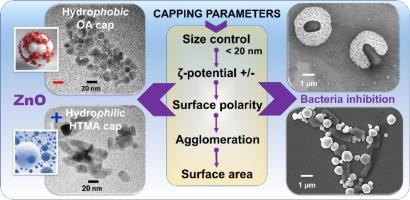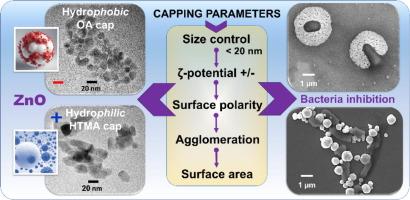封盖剂对ZnO纳米颗粒理化及抗菌性能的控制
IF 6.9
2区 材料科学
Q2 CHEMISTRY, PHYSICAL
引用次数: 0
摘要
生命科学研究在很大程度上受益于纳米颗粒(NP)的使用,但诸如胶体稳定性和对NP大小和形状的控制等基本问题影响着NP在生物医学应用中的性质和功能。本研究表明,在氧化锌NP合成中直接加入封盖剂可以更好地控制这些性质及其增强的功能。系统研究了封盖剂对微波(M W)辅助多元醇法制备ZnO NP的理化性能和抗菌性能的影响。初始NP大小(10 ~ 20 nm)受锌前驱体浓度控制,NP形状受封盖剂类型影响。封盖剂可以控制氧化锌的表面电荷和水相互作用特性,以便进一步研究涉及细菌的氧化锌。带正电、亲水的hmta包覆ZnO具有较好的抗菌效果,而带负电、疏水的oa包覆ZnO仍具有抗菌效果。这些观察结果表明了不同的潜在机制,我们讨论了这些差异,特别是氧化锌的比表面积,以及这是细菌-纳米颗粒相互作用的关键。选择合适的封盖剂是合成有效的ZnO纳米粒子的关键,用于抗菌应用,特别是对抗抗性。本文章由计算机程序翻译,如有差异,请以英文原文为准。


Capping agent control over the physicochemical and antibacterial properties of ZnO nanoparticles
Life science research has largely benefited from the use of nanoparticles (NPs), yet fundamental issues such as colloidal stability and control over NP size and shape affect NP properties and functions in biomedical applications. Here we show that including capping agents directly into zinc oxide (ZnO) NP synthesis can lead to better control of these properties and their enhanced functionality. A systematic study of the influence capping agents has on the physicochemical and antibacterial properties of ZnO NP synthesized using the microwave (MW)-assisted polyol method is presented. Primary NP size (10–20 nm) was controlled by zinc precursor concentration, and NP shape was influenced by capping agent type. Capping agents enabled control over the surface charge and water interaction properties of ZnO for further investigations involving bacteria. The superior antibacterial effect was observed using positively charged, hydrophilic HMTA-capped ZnO, yet negatively charged hydrophobic OA-capped ZnO still exhibited an antibacterial effect. These observations suggest different underlying mechanisms, and we discuss these differences with particular reference to the specific surface area of ZnO, and how this is key to bacteria-nanoparticle interactions. Appropriate selection of capping agents is crucial for the synthesis of potent ZnO NPs intended for antibacterial applications, specifically for combating resistance.
求助全文
通过发布文献求助,成功后即可免费获取论文全文。
去求助
来源期刊

Applied Surface Science
工程技术-材料科学:膜
CiteScore
12.50
自引率
7.50%
发文量
3393
审稿时长
67 days
期刊介绍:
Applied Surface Science covers topics contributing to a better understanding of surfaces, interfaces, nanostructures and their applications. The journal is concerned with scientific research on the atomic and molecular level of material properties determined with specific surface analytical techniques and/or computational methods, as well as the processing of such structures.
 求助内容:
求助内容: 应助结果提醒方式:
应助结果提醒方式:


